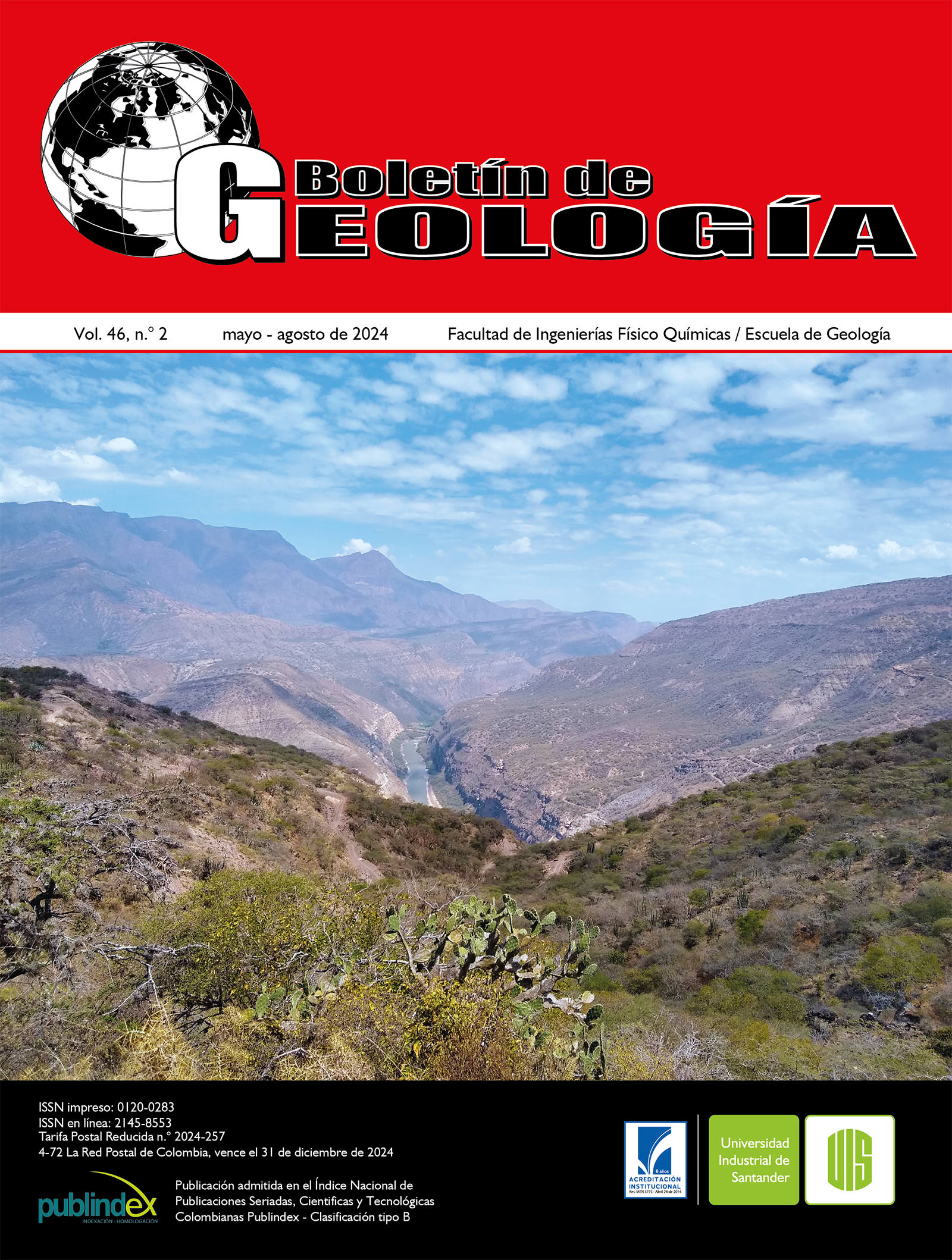Petrophysical characterization of the reservoir in the Santa Cruz oilfield in Cuba
Published 2024-06-14
Keywords
- Carbonate reservoirs,
- Properties,
- Fracturation,
- Well logs
How to Cite
Copyright (c) 2024 Boletín de Geología

This work is licensed under a Creative Commons Attribution 4.0 International License.
Altmetrics
Abstract
In the Cuban Northern Oil Belt there is a group of oilfields with carbonate reservoirs, belonging to the Veloz Group formations, within the Placetas Tectonic Stratigraphic Unit. These oilfields have a common history, where their composition is similar. However, the reservoir properties vary from one to another and within the same reservoir due to different wells locations. Based on this reality, several studies have been executed, which have discovered factors that can enhance or hinder production. The complex geology of folds and sheets plays an important role in the differences, where a structured fracturing improves the permeability of the rocks. The present paper is developed in the Santa Cruz oil field, where key wells were selected to represent each of the three blocks that constitute it. The wells selected for the analysis have a complete set of conventional logs in the reservoir, the electrical borehole imaging (FMI) log and the lithology described in the wells with the borehole cuttings. The principal objective was to characterize the oilfield reservoir by petrophysic. As a result, reservoir properties were calculated: clay volume, effective porosity, water saturation and effective thicknesses, after establishing cut off values for each sector or block. Additionally, geomechanical properties were evaluated in a key well.
Downloads
References
- Acevedo, O.D. (2009). Determinación de la magnitud de esfuerzos in situ. Tesis, Universidad Nacional Autónoma de México.
- Álvarez, J.; Fernández, J.; Hernández, J.; Castro, O.; Otero, R.; Pérez, L.; Pérez, Y.; Rodríguez, R. (2004). Proyecto 2106. Informe final del pozo Santa Cruz 100. Archivo Técnico Ceinpet, La Habana.
- Álvarez, J.; Blanco, S.; Hernández, J.; Fernández, J.; Pérez, L.; Otero, R.; Castro, O.; Brey, D.; Pérez, Y.; Rodríguez, R. (2006). Proyecto 2106. Informe final del pozo Santa Cruz 200. Archivo Técnico Ceinpet, La Habana.
- Bratton, T.; Viet Canh, D.; Van Que, N; V. Duc., N.; Gillespie, P.; Hunt, D.; Li, B.; Marcinew, R.; Ray, S.; Montaron, B.; Nelson, R.; Schoderbek, D.; Sonneland, L. (2006). La naturaleza de los yacimientos naturalmente fracturados. Oilfield Review, 4-25.
- Calderón, F.M.; Rincón, A.C. (2010). Diseño e implementación de una herramienta software de edición de registros sónicos reales y sintéticos para la estimación de propiedades geomecánicas de las rocas. Tesis, Universidad Industrial de Santander, Bucaramanga, Colombia.
- Castro, O.; Brey, D.; Hernández J. (2006). Main electrofacies in carbonates of the heavy crudes northern belt of Cuba, SPWLA 47th Annual Logging Symposium, Veracruz, México.
- Castro, O. (2017). Flujo de trabajo para la evaluación petrofísica de las formaciones. En: O. Castro (ed.). Evaluación petrofísica de formaciones gasopetrolíferas cubanas (pp. 31-57). Centro Nacional de Información Geológica.
- Castro-Castriñeira, O.; Moya, C. (2019). Flujo de trabajo para optimizar el uso de registros geofísicos convencionales al caracterizar reservorios carbonatados. Geociencias UP, 2(1), 5-14.
- Crain, E.R. (1986). The Log Analysis Handbook, Volume 1 «Quantitative Methods». PennWell Books.
- Davis, J.C. (1986). Statistics and Data Analysis in Geology. 2nd ed. John Wiley & and Sons, Inc.
- Diéguez, D.; Hernández, R.; Ortega, Y.; Díaz, A.M.; Cabello, W.; Miquel, L.; Suárez, L.; Rodríguez, E.; Perera, C.; Pérez, L.; Blanco, S.; Carballo, K.; Pérez, O.; González, O.; Griñán, I. (2020). Servicio Científico Técnico: Informe final del pozo Santa Cruz 203. Archivo Técnico Ceinpet, La Habana.
- GeolOil (2014). How to calculate Petrophysicals Cutoffs. https://www.geoloil.com/petroCutoffs.php
- Nacer-Bey, R.; Chibah, R. (1995). II-3 Carbonate Reservoirs in Algeria. Contribution from Sonatrach, Exploration Division. Schlumberger WEC Sonatrach (pp II-3-1 – II-3-15). Schlumberger.
- Páez, L.R. (2007). Apuntes de Mecánica de Rocas. Universidad Autónoma de Chihuahua, México.
- Portillo, M.C. (2011). Análisis geomecánico en pozos del Yacimiento C-Inferior VLC-363, susceptibles a migración de finos. Tesis de Maestría, Universidad del Zulia, Venezuela.
- Reyes, O.; Brey, D.; Castro, O.; González, E.M.; Gines, W.; García, A.; Fernández, P.A. (2021). Definición de estructuras gasopetrolíferas en el Sector Santa Cruz de la Franja Norte Petrolera Cubana. Etapa I.2, informe parcial: Correlación sismo-geológica, Proyecto 5501. Archivo Técnico Ceinpet, La Habana.
- Schlumberger (1991). Principios/Aplicaciones de la interpretación de registros. Schlumberger Educational Services.
- Valladares, S.; Castro, O.; Rodríguez, N.; González, D.; Torres, M.; Garciga, A.; Hernández, L.; Álvarez, J.; Cruz, R.; Mejías, L.; Linares, E.; Flores, A.; Blanco, S.; González, O.; García, D.; Tamayo, Y.; Rosell, Y.; Reyes, O.; Veiga, C.; Prieto, F.; (2023). Caracterización de los reservorios gasopetrolíferos de la República de Cuba. Etapa I: Reservorios carbonatados y terrígeno – carbonatados pertenecientes a las diferentes Unidades tectono-estratigráficas de los dominios Las Villas y Pinar del Río. Archivo Técnico Ceinpet, La Habana.

